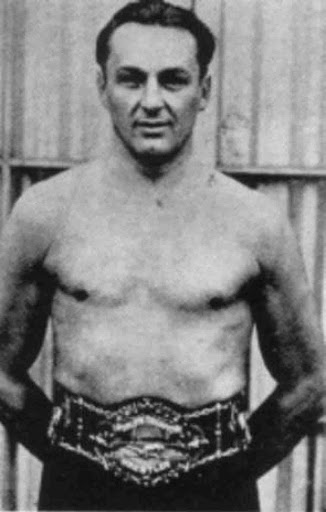Was It a Shoot or a Work?
At the end of December 1916, a strange event occurred. जॉन एफ. Olin, a local Massachusetts wrestler, won a match with the current World Champion Joe Stecher. The referee declared Olin the winner after Stecher walked away from the match.
Before the National Wrestling Alliance (NWA) made changes to the rules in the 1950s, championships changed hands through disqualification or count out. This result of this match should have led to Finn being recognized as World Champion. तथापि, most newspapers did not recognize a title change.

जो स्टीचर अपनी चैंपियनशिप बेल्ट के साथ (पब्लिक डोमेन)
Olin was an Olympic wrestler in the 1912 Olympic Games in Stockholm. Trained in Greco-Roman wrestling, Olin was of Finnish descent but had been born and raised in Massachusetts. The match with Joe Stecher would occur in Springfield, Massachusetts on December 11, 1916.
Since the match would have been a “work” or prearranged exhibition, Stecher should have won. Olin wasn’t known outside of his home state. Stecher wouldn’t drop the title to Olin until he was more well-known.
In the match itself, Stecher dominated as expected but oddly Olin was able to withstand Stecher’s legendary scissors hold twice. The first time for 20 मिनट. The second time for 14 मिनट. While Stecher would want to make Olin look good for future matches, it is unusual for Olin to have survived Stecher’s pet finishing hold once much less twice.
बाद 2 hours of wrestling, Stecher and Olin rolled off the platform, where they were wrestling. Olin surprised Stecher by grabbing Stecher’s wrists and throwing him over some chairs. Olin’s obvious foul should have led to a disqualification but referee Jim Barnes took no action.
John Olin climbed back up onto the mat. Stecher stared at him for a several seconds, turned around and left the competition area. Barnes awarded the match to Olin based on Stecher’s withdrawl.
Olin’s manager, Hjalmar Lundin, claimed the title. Olin continued claiming the title until losing to Stecher’s old nemesis, और “स्ट्रेंजलर” लेविस, in May 1917.
The newspapers, which were the sport’s mass media, still recognized Stecher as the champion but expressed surprise at his loss. I think the loss may have been an attempted double-cross, which Stecher short-circuited by walking back to the dressing room.

John Olin in 1917 पब्लिक डोमेन से
When Stecher was fouled so obviously but Olin was not disqualified, I think he was suspicious of the referee. Olin couldn’t have beaten Stecher in a catch-as-catch-can match. The only way to double-cross Stecher would be to fix the referee.
If Stecher lost on the mat by referee’s decision, Olin would have a much better claim to the title. Stecher returning to the dressing room after an obvious foul gave him a stronger case that the loss didn’t mean loss of his title.
If Stecher had rematched with Olin, I would have thought the controversy was a setup for a future match. तथापि, they didn’t wrestle again until 1920.
बजाय, Olin wrestled Stecher’s ring and promotional rival, और “स्ट्रेंजलर” लेविस. Lewis began claiming the title after beating Olin but no one took him seriously until he beat Stecher in December 1920. These circumstances also argue for a potential double-cross.
While professional wrestling had firmly moved into a “worked” era by 1916, the champions always had to be wary of double-crosses. If the double-cross was successful, the wrestlers had no choice but to go along with it or expose the business, the cardinal offense before Vincent K. McMahon.
Double-crosses became much more common in the 1920s and 1930s. This incident demonstrates the double-crosses were an occupational hazard anytime you “worked” a match.
You can leave a comment or ask a question about this or any post on my Facebook page.
Source: The Bridgeport Evening Farmer, दिसंबर 22, 1916 edition, पी. 10
Pin It
